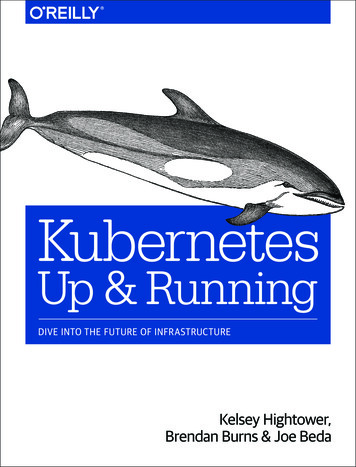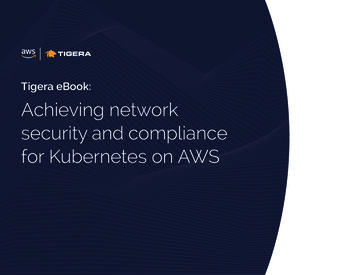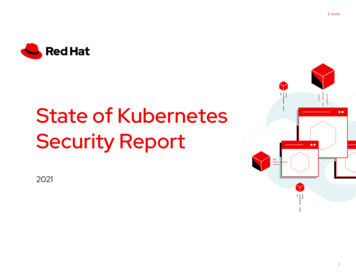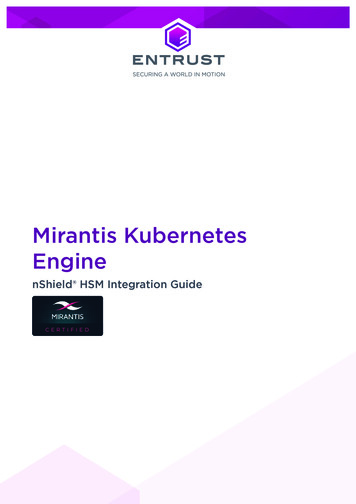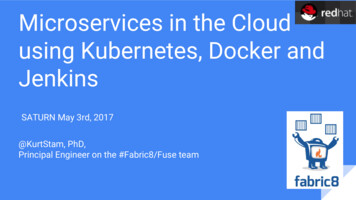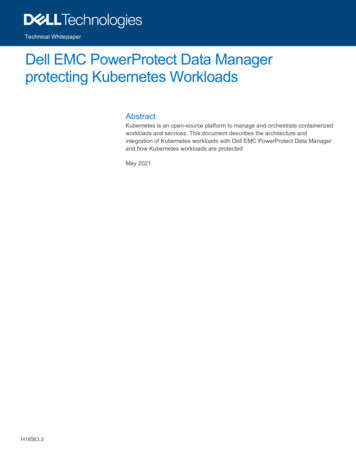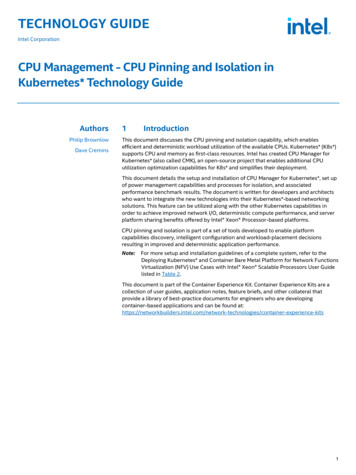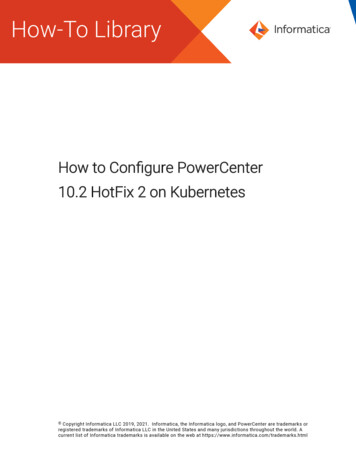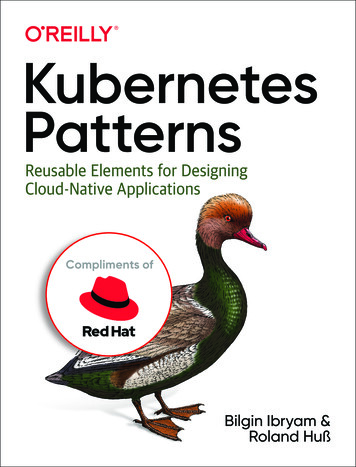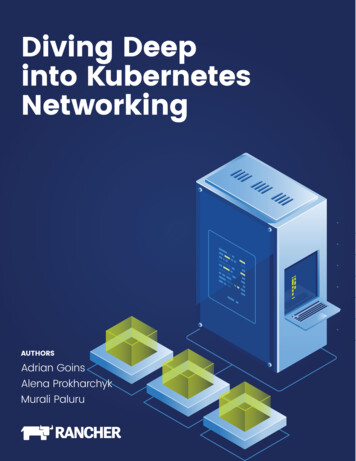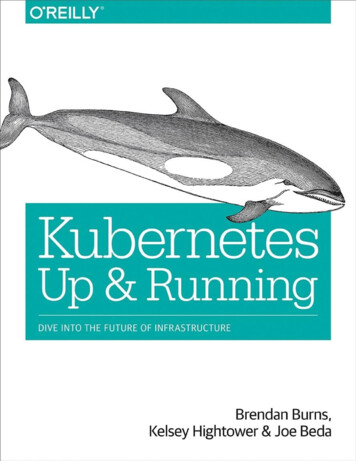
Transcription
Kubernetes: Up and RunningDive into the Future of InfrastructureKelsey Hightower, Brendan Burns, and Joe Beda
Kubernetes: Up and Runningby Kelsey Hightower, Brendan Burns, and Joe BedaCopyright 2017 Kelsey Hightower, Brendan Burns, and Joe Beda. All rightsreserved.Printed in the United States of America.Published by O’Reilly Media, Inc., 1005 Gravenstein Highway North,Sebastopol, CA 95472.O’Reilly books may be purchased for educational, business, or sales promotionaluse. Online editions are also available for most titles (http://oreilly.com/safari).For more information, contact our corporate/institutional sales department: 800998-9938 or corporate@oreilly.com.Editor: Angela RufinoProduction Editor: Melanie YarbroughCopyeditor: Christina EdwardsProofreader: Rachel HeadIndexer: Kevin BroccoliInterior Designer: David FutatoCover Designer: Karen MontgomeryIllustrator: Rebecca DemarestSeptember 2017: First Edition
Revision History for the First Edition2017-09-05: First ReleaseSee http://oreilly.com/catalog/errata.csp?isbn 9781491935675 for releasedetails.The O’Reilly logo is a registered trademark of O’Reilly Media, Inc. Kubernetes:Up and Running, the cover image, and related trade dress are trademarks ofO’Reilly Media, Inc.While the publisher and the authors have used good faith efforts to ensure thatthe information and instructions contained in this work are accurate, thepublisher and the authors disclaim all responsibility for errors or omissions,including without limitation responsibility for damages resulting from the use ofor reliance on this work. Use of the information and instructions contained inthis work is at your own risk. If any code samples or other technology this workcontains or describes is subject to open source licenses or the intellectualproperty rights of others, it is your responsibility to ensure that your use thereofcomplies with such licenses and/or rights.978-1-491-93567-5[LSI]
For Klarissa and Kelis, who keep me sane. And for my Mom, who taught me astrong work ethic and how to rise above all odds. — Kelsey HightowerFor my Dad, who helped me fall in love with computers by bringing homepunch cards and dot matrix banners. — Joe BedaFor Robin, Julia, Ethan, and everyone who bought cookies to pay for thatCommodore 64 in my third-grade class. — Brendan Burns
Preface
Kubernetes: A DedicationKubernetes would like to thank every sysadmin who has woken up at 3 a.m. torestart a process. Every developer who pushed code to production only to findthat it didn’t run like it did on their laptop. Every systems architect whomistakenly pointed a load test at the production service because of a leftoverhostname that they hadn’t updated. It was the pain, the weird hours, and theweird errors that inspired the development of Kubernetes. In a single sentence:Kubernetes intends to radically simplify the task of building, deploying, andmaintaining distributed systems. It has been inspired by decades of real-worldexperience building reliable systems and it has been designed from the groundup to make that experience, if not euphoric, at least pleasant. We hope you enjoythe book!
Who Should Read This BookWhether you are new to distributed systems or have been deploying cloud-nativesystems for years, containers and Kubernetes can help you achieve new levels ofvelocity, agility, reliability, and efficiency. This book describes the Kubernetescluster orchestrator and how its tools and APIs can be used to improve thedevelopment, delivery, and maintenance of distributed applications. Though noprevious experience with Kubernetes is assumed, to make maximal use of thebook you should be comfortable building and deploying server-basedapplications. Familiarity with concepts like load balancers and network storagewill be useful, though not required. Likewise, experience with Linux, Linuxcontainers, and Docker, though not essential, will help you make the most of thisbook.
Why We Wrote This BookWe have been involved with Kubernetes since its very beginnings. It has beentruly remarkable to watch it transform from a curiosity largely used inexperiments to a crucial production-grade infrastructure that powers large-scaleproduction applications in varied fields, from machine learning to onlineservices. As this transition occurred, it became increasingly clear that a book thatcaptured both how to use the core concepts in Kubernetes and the motivationsbehind the development of those concepts would be an important contribution tothe state of cloud-native application development. We hope that in reading thisbook, you not only learn how to build reliable, scalable applications on top ofKubernetes, but also that you receive insight into the core challenges ofdistributed systems that led to its development.
A Word on Cloud-Native Applications TodayFrom the first programming languages, to object-oriented programming, to thedevelopment of virtualization and cloud infrastructure, the history of computerscience is a history of the development of abstractions that hide complexity andempower you to build ever more sophisticated applications. Despite this, thedevelopment of reliable, scalable applications is still dramatically morechallenging than it ought to be. In recent years, containers and containerorchestration APIs like Kubernetes have become an important abstraction thatradically simplifies the development of reliable, scalable distributed systems.Though containers and orchestrators are still in the process of entering themainstream, they are already enabling developers to build and deployapplications with a speed, agility, and reliability that would have seemed likescience fiction only a few years ago.
Navigating This BookThis book is organized as follows. The first chapter outlines the high-levelbenefits of Kubernetes without diving too deeply into the details. If you are newto Kubernetes, this is a great place to start to understand why you should read therest of the book.The following chapter provides a detailed introduction to containers andcontainerized application development. If you’ve never really played aroundwith Docker before, this chapter will be a useful introduction. If you are alreadya Docker expert, it will likely be mostly review.Chapter 3 covers how to deploy Kubernetes. While most of this book focuses onhow to use Kubernetes, you need to get a cluster up and running before you startusing it. While running a cluster for production is out of the scope of this book,this chapter presents a couple of easy ways to create a cluster so that you canunderstand how to use Kubernetes.Starting with Chapter 5, we dive into the details of deploying an applicationusing Kubernetes. We cover Pods (Chapter 5), labels and annotations(Chapter 6), services (Chapter 7), and ReplicaSets (Chapter 8). These form thecore basics of what you need to deploy your service in Kubernetes.After those chapters, we cover some more specialized objects in Kubernetes:DaemonSets (Chapter 9), jobs (Chapter 10), and ConfigMaps and secrets(Chapter 11). While these chapters are essential for many productionapplications, if you are just learning Kubernetes they can be skipped andreturned to later, after you gain more experience and expertise.We then cover deployments (Chapter 12), which tie together the lifecycle of acomplete application, and integrating storage into Kubernetes (Chapter 13).Finally, we conclude with some examples of how to develop and deploy realworld applications in Kubernetes.
Online ResourcesYou will want to install Docker. You likely will also want to familiarize yourselfwith the Docker documentation if you have not already done so.Likewise, you will want to install the kubectl command-line tool. You may alsowant to join the Kubernetes slack channel, where you will find a largecommunity of users who are willing to talk and answer questions at nearly anyhour of the day.Finally, as you grow more advanced, you may want to engage with the opensource Kubernetes repository on GitHub.
Conventions Used in This BookThe following typographical conventions are used in this book:ItalicIndicates new terms, URLs, email addresses, filenames, and file extensions.Constant widthUsed for program listings, as well as within paragraphs to refer to programelements such as variable or function names, databases, data types,environment variables, statements, and keywords.Constant width boldShows commands or other text that should be typed literally by the user.Constant width italicShows text that should be replaced with user-supplied values or by valuesdetermined by context.NOTEThis icon signifies a tip, suggestion, or general note.WARNINGThis icon indicates a warning or caution.
Using Code ExamplesSupplemental material (code examples, exercises, etc.) is available for downloadat les.This book is here to help you get your job done. In general, if example code isoffered with this book, you may use it in your programs and documentation. Youdo not need to contact us for permission unless you’re reproducing a significantportion of the code. For example, writing a program that uses several chunks ofcode from this book does not require permission. Selling or distributing a CDROM of examples from O’Reilly books does require permission. Answering aquestion by citing this book and quoting example code does not requirepermission. Incorporating a significant amount of example code from this bookinto your product’s documentation does require permission.We appreciate, but do not require, attribution. An attribution usually includes thetitle, author, publisher, and ISBN. For example: “Kubernetes: Up and Runningby Kelsey Hightower, Brendan Burns, and Joe Beda (O’Reilly). Copyright 2017Kelsey Hightower, Brendan Burns, and Joe Beda, 978-1-491-93567-5.”If you feel your use of code examples falls outside fair use or the permissiongiven above, feel free to contact us at permissions@oreilly.com.
O’Reilly SafariNOTESafari (formerly Safari Books Online) is a membership-based training andreference platform for enterprise, government, educators, and individuals.Members have access to thousands of books, training videos, Learning Paths,interactive tutorials, and curated playlists from over 250 publishers, includingO’Reilly Media, Harvard Business Review, Prentice Hall Professional, AddisonWesley Professional, Microsoft Press, Sams, Que, Peachpit Press, Adobe, FocalPress, Cisco Press, John Wiley & Sons, Syngress, Morgan Kaufmann, IBMRedbooks, Packt, Adobe Press, FT Press, Apress, Manning, New Riders,McGraw-Hill, Jones & Bartlett, and Course Technology, among others.For more information, please visit http://oreilly.com/safari.
How to Contact UsPlease address comments and questions concerning this book to the publisher:O’Reilly Media, Inc.1005 Gravenstein Highway NorthSebastopol, CA 95472800-998-9938 (in the United States or Canada)707-829-0515 (international or local)707-829-0104 (fax)We have a web page for this book, where we list errata, examples, and anyadditional information. You can access this page at http://bit.ly/kubernetes-upand-running.To comment or ask technical questions about this book, send email tobookquestions@oreilly.com.For more information about our books, courses, conferences, and news, see ourwebsite at http://www.oreilly.com.Find us on Facebook: http://facebook.com/oreillyFollow us on Twitter: http://twitter.com/oreillymediaWatch us on YouTube: http://www.youtube.com/oreillymedia
Chapter 1. IntroductionKubernetes is an open source orchestrator for deploying containerizedapplications. Kubernetes was originally developed by Google, inspired by adecade of experience deploying scalable, reliable systems in containers viaapplication-oriented APIs.1But Kubernetes is much more than simply exporting technology developed atGoogle. Kubernetes has grown to be the product of a rich and growing opensource community. This means that Kubernetes is a product that is suited not justto the needs of internet-scale companies but to cloud-native developers of allscales, from a cluster of Raspberry Pi computers to a warehouse full of the latestmachines. Kubernetes provides the software necessary to successfully build anddeploy reliable, scalable distributed systems.You may be wondering what we mean when we say “reliable, scalabledistributed systems.” More and more services are delivered over the network viaAPIs. These APIs are often delivered by a distributed system, the various piecesthat implement the API running on different machines, connected via thenetwork and coordinating their actions via network communication. Because werely on these APIs increasingly for all aspects of our daily lives (e.g., findingdirections to the nearest hospital), these systems must be highly reliable. Theycannot fail, even if a part of the system crashes or otherwise fails. Likewise, theymust maintain availability even during software rollouts or other maintenanceevents. Finally, because more and more of the world is coming online and usingsuch services, they must be highly scalable so that they can grow their capacityto keep up with ever-increasing usage without radical redesign of the distributedsystem that implements the services.Depending on when and why you have come to hold this book in your hands,you may have varying degrees of experience with containers, distributedsystems, and Kubernetes. Regardless of what your experience is, we believe thisbook will enable you to make the most of your use of Kubernetes.There are many reasons why people come to use containers and container APIslike Kubernetes, but we believe they effectively all can be traced back to one of
these benefits:VelocityScaling (of both software and teams)Abstracting your infrastructureEfficiencyIn the following sections we describe how Kubernetes can help provide each ofthese benefits.
VelocityVelocity is the key component in nearly all software development today. Thechanging nature of software from boxed software shipped on CDs to web-basedservices that change every few hours means that the difference between you andyour competitors is often the speed with which you can develop and deploy newcomponents and features.It is important to note, however, that this velocity is not defined in terms ofsimply raw speed. While your users are always looking for iterativeimprovement, they are more interested in a highly reliable service. Once upon atime, it was OK for a service to be down for maintenance at midnight everynight. But today, our users expect constant uptime, even if the software they arerunning is changing constantly.Consequently, velocity is measured not in terms of the raw number of featuresyou can ship per hour or day, but rather in terms of the number of things you canship while maintaining a highly available service.In this way, containers and Kubernetes can provide the tools that you need tomove quickly, while staying available. The core concepts that enable this areimmutability, declarative configuration, and online self-healing systems. Theseideas all interrelate to radically improve the speed with which you can reliablydeploy software.
The Value of ImmutabilityContainers and Kubernetes encourage developers to build distributed systemsthat adhere to the principles of immutable infrastructure. With immutableinfrastructure, once an artifact is created in the system it does not change viauser modifications.Traditionally, computers and software systems have been treated as mutableinfrastructure. With mutable infrastructure, changes are applied as incrementalupdates to an existing system. A system upgrade via the apt-get update tool isa good example of an update to a mutable system. Running apt sequentiallydownloads any updated binaries, copies them on top of older binaries, and makesincremental updates to configuration files. With a mutable system, the currentstate of the infrastructure is not represented as a single artifact, but rather anaccumulation of incremental updates and changes. On many systems theseincremental updates come from not just system upgrades but operatormodifications as well.In contrast, in an immutable system, rather than a series of incremental updatesand changes, an entirely new, complete image is built, where the update simplyreplaces the entire image with the newer image in a single operation. There areno incremental changes. As you can imagine, this is a significant shift from themore traditional world of configuration management.To make this more concrete in the world of containers, consider two differentways to upgrade your software:1. You can log into a container, run a command to download your newsoftware, kill the old server, and start the new one.2. You can build a new container image, push it to a container registry, killthe existing container, and start a new one.At first blush, these two approaches might seem largely indistinguishable. Sowhat is it about the act of building a new container that improves reliability?The key differentiation is the artifact that you create, and the record of how youcreated it. These records make it easy to understand exactly the differences insome new version and, if something goes wrong, determine what has changed
and how to fix it.Additionally, building a new image rather than modifying an existing one meansthe old image is still around, and can quickly be used for a rollback if an erroroccurs. In contrast, once you copy your new binary over an existing binary, suchrollback is nearly impossible.Immutable container images are at the core of everything that you will build inKubernetes. It is possible to imperatively change running containers, but this isan antipattern to be used only in extreme cases where there are no other options(e.g., if it is the only way to temporarily repair a mission-critical productionsystem). And even then, the changes must also be recorded through a declarativeconfiguration update at some later time, after the fire is out.
Declarative ConfigurationImmutability extends beyond containers running in your cluster to the way youdescribe your application to Kubernetes. Everything in Kubernetes is adeclarative configuration object that represents the desired state of the system. Itis Kubernetes’s job to ensure that the actual state of the world matches thisdesired state.Much like mutable versus immutable infrastructure, declarative configuration isan alternative to imperative configuration, where the state of the world is definedby the execution of a series of instructions rather than a declaration of thedesired state of the world. While imperative commands define actions,declarative configurations define state.To understand these two approaches, consider the task of producing threereplicas of a piece of software. With an imperative approach, the configurationwould say: “run A, run B, and run C.” The corresponding declarativeconfiguration would be “replicas equals three.”Because it describes the state of the world, declarative configuration does nothave to be executed to be understood. Its impact is concretely declared. Since theeffects of declarative configuration can be understood before they are executed,declarative configuration is far less error-prone. Further, the traditional tools ofsoftware development, such as source control, code review, and unit testing, canbe used in declarative configuration in ways that are impossible for imperativeinstructions.The combination of declarative state stored in a version control system andKubernetes’s ability to make reality match this declarative state makes rollbackof a change trivially easy. It is simply restating the previous declarative state ofthe system. With imperative systems this is usually impossible, since while theimperative instructions describe how to get you from point A to point B, theyrarely include the reverse instructions that can get you back.
Self-Healing SystemsKubernetes is an online, self-healing system. When it receives a desired stateconfiguration, it does not simply take actions to make the current state match thedesired state a single time. It continuously takes actions to ensure that the currentstate matches the desired state. This means that not only will Kubernetesinitialize your system, but it will guard it against any failures or perturbationsthat might destabilize your system and affect reliability.A more traditional operator repair involves a manual series of mitigation steps,or human intervention performed in response to some sort of alert. Imperativerepair like this is more expensive (since it generally requires an on-call operatorto be available to enact the repair). It is also generally slower, since a humanmust often wake up and log in to respond. Furthermore, it is less reliable sincethe imperative series of repair operations suffer from all of the problems ofimperative management described in the previous section. Self-healing systemslike Kubernetes both reduce the burden on operators and improve the overallreliability of the system by performing reliable repairs more quickly.As a concrete example of this self-healing behavior, if you assert a desired stateof three replicas to Kubernetes, it does not just create three replicas — itcontinuously ensures that there are exactly three replicas. If you manually createa fourth replica Kubernetes will destroy one to bring the number back to three. Ifyou manually destroy a replica, Kubernetes will create one to again return you tothe desired state.Online self-healing systems improve developer velocity because the time andenergy you might otherwise have spent on operations and maintenance caninstead be spent on developing and testing new features.
Scaling Your Service and Your TeamsAs your product grows, its inevitable that you will need to scale both yoursoftware and the teams that develop it. Fortunately, Kubernetes can help withboth of these goals. Kubernetes achieves scalability by favoring decoupledarchitectures.
DecouplingIn a decoupled architecture each component is separated from other componentsby defined APIs and service load balancers. APIs and load balancers isolate eachpiece of the system from the others. APIs provide a buffer between implementerand consumer, and load balancers provide a buffer between running instances ofeach service.Decoupling components via load balancers makes it easy to scale the programsthat make up your service, because increasing the size (and therefore thecapacity) of the program can be done without adjusting or reconfiguring any ofthe other layers of your service.Decoupling servers via APIs makes it easier to scale the development teamsbecause each team can focus on a single, smaller microservice with acomprehensible surface area. Crisp APIs between microservices limit theamount of cross-team communication overhead required to build and deploysoftware. This communication overhead is often the major restricting factorwhen scaling teams.
Easy Scaling for Applications and ClustersConcretely, when you need to scale your service, the immutable, declarativenature of Kubernetes makes this scaling trivial to implement. Because yourcontainers are immutable, and the number of replicas is simply a number in adeclarative config, scaling your service upward is simply a matter of changing anumber in a configuration file, asserting this new declarative state to Kubernetes,and letting it take care of the rest. Alternately, you can set up autoscaling andsimply let Kubernetes take care of it for you.Of course, that sort of scaling assumes that there are resources available in yourcluster to consume. Sometimes you actually need to scale up the cluster itself.Here again, Kubernetes makes this task easier. Because each machine in a clusteris entirely identical to every other machine, and the applications themselves aredecoupled from the details of the machine by containers, adding additionalresources to the cluster is simply a matter of imaging a new machine and joiningit into the cluster. This can be accomplished via a few simple commands or via aprebaked machine image.One of the challenges of scaling machine resources is predicting their use. If youare running on physical infrastructure, the time to obtain a new machine ismeasured in days or weeks. On both physical and cloud infrastructure, predictingfuture costs is difficult because it is hard to predict the growth and scaling needsof specific applications.Kubernetes can simplify forecasting future compute costs. To understand whythis is true, consider scaling up three teams, A, B, and C. Historically you haveseen that each team’s growth is highly variable and thus hard to predict. If youare provisioning individual machines for each service, you have no choice but toforecast based on the maximum expected growth for each service, sincemachines dedicated to one team cannot be used for another team. If instead youuse Kubernetes to decouple the teams from the specific machines they are using,you can forecast growth based on the aggregate growth of all three services.Combining three variable growth rates into a single growth rate reducesstatistical noise and produces a more reliable forecast of expected growth.Furthermore, decoupling the teams from specific machines means that teams canshare fractional parts of each other’s machines, reducing even further the
overheads associated with forecasting growth of computing resources.
Scaling Development Teams with MicroservicesAs noted in a variety of research, the ideal team size is the “two-pizza team,” orroughly six to eight people, because this group size often results in goodknowledge sharing, fast decision making, and a common sense of purpose.Larger teams tend to suffer from hierarchy, poor visibility, and infighting, whichhinder agility and success.However, many projects require significantly more resources to be successfuland achieve their goals. Consequently, there is a tension between the ideal teamsize for agility and the necessary team size for the product’s end goals.The common solution to this tension has been the development of decoupled,service-oriented teams that each build a single microservice. Each small team isresponsible for the design and delivery of a service that is consumed by othersmall teams. The aggregation of all of these services ultimately provides theimplementation of the overall product’s surface area.Kubernetes provides numerous abstractions and APIs that make it easier to buildthese decoupled microservice architectures.Pods, or groups of containers, can group together container imagesdeveloped by different teams into a single deployable unit.Kubernetes services provide load balancing, naming, and discovery toisolate one microservice from another.Namespaces provide isolation and access control, so that each microservicecan control the degree to which other services interact with it.Ingress objects provide an easy-to-use frontend that can combine multiplemicroservices into a single externalized API surface area.Finally, decoupling the application container image and machine means thatdifferent microservices can colocate on the same machine without interferingwith each other, reducing the overhead and cost of microservice architectures.The health-checking and rollout features of Kubernetes guarantee a consistentapproach to application rollout and reliability that ensures that a proliferation ofmicroservice teams does not also result in a proliferation of different approaches
to service production lifecycle and operations.
Separation of Concerns for Consistency and ScalingIn addition to the consistency that Kubernetes brings to operations, thedecoupling and separation of concerns produced by the Kubernetes stack lead tosignificantly greater consistency for the lower levels of your infrastructure. Thisenables your operations function to scale to managing many machines with asingle small, focused team. We have talked at length about the decoupling ofapplication container and machine/operating system (OS), but an importantaspect of this decoupling is that the container orchestration API becomes a crispcontract that separates the responsibilities of the application operator from thecluster orchestration operator. We call this the “not my monkey, not my circus”line. The application developer relies on the service-level agreement (SLA)delivered by the container orchestration API, without worrying about the detailsof how this SLA is achieved. Likewise, the container orchestration APIreliability engineer focuses on delivering the orchestration API’s SLA withoutworrying about the applications that are running on top of it.This decoupling of concerns means that a small team running a Kubernetescluster can be responsible for supporting hundreds or even thousands of teamsrunning applications within that cluster (Figure 1-1). Likewise, a small team canbe responsible for tens (or more) of clusters running around the world. It’simportant to note that the same decoupling of containers and OS enables the OSreliability engineers to focus on the SLA of the individual machine’s OS. Thisbecomes another line of separate responsibility, with the Kubernetes operatorsrelying on the OS SLA, and the OS operators worrying solely about deliveringthat SLA. Again, this enables you to scale a small team of OS experts to a fleetof thousands of machines.
Figure 1-1. An illustration of how different operations teams are decoupled using APIsOf course, devoting even a small team to managing an OS is beyond the scale ofmany organizations. In these environments, a managed Kubernetes-as-a-Service(KaaS) provided by a public cloud provider is a great option.NOTE
At the time of writing, you can use managed KaaS on Microsoft Azure, with Azure ContainerService, as well as on the Google Cloud Platform via the Google Container Engin
applications. Kubernetes was originally developed by Google, inspired by a decade of experience deploying scalable, reliable systems in containers via application-oriented APIs.1 But Kubernetes is much more than simply exporting technology developed at Google. Kubernetes has grown to be the product of a rich and growing open source community.
